![]()
![]()
![]()
Use LEFT and RIGHT arrow keys to navigate between flashcards;
Use UP and DOWN arrow keys to flip the card;
H to show hint;
A reads text to speech;
67 Cards in this Set
- Front
- Back
- 3rd side (hint)
|
Donor portrait |
Person who commissioned it |
|
|
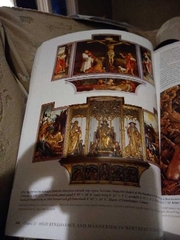
Polyptych |
3 panel for Altarpiece. Matthias Grunewald. Isenheim Altarpiece.oil. Holy Roman |
|
|
|
|
An artwork on paper, usually produced in multiple impressions. |
|
|
|
Alchemy |
The study of seemingly magical changes, especially chemical changes. |
|
|
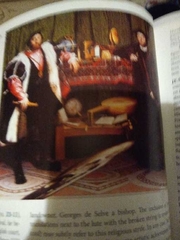
Anamorphic image |
a distorted image recognizable only when viewed with a special device, such as a cylindrical mirror or by looking at the painting at an acute angle Hans holbein the younger. The French ambassadors. Oil and tempera on wood. France. |
|
|
|
Genre |
One from daily life. A style or category of art. |
|
|
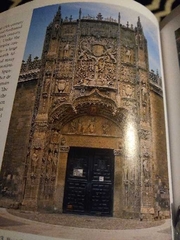
Plateresque |
a style of Spanish architecture characterized by elaborate decoration based on Gothic, Italian Renaissance, and Islamic sources derived from the Spanish word up platero meaning of silversmith. Ex: portal. Colegio de San Gregorio. Spain. |
|
|
|
Atrium |
the central reception room of a Roman house that is partially open to the sky. Also the open, colonnaded court in front of and attached to a Christian basilica. |
|
|
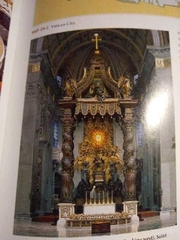
Baldacchino |
Baldacchino. A canopy on columns, frequently built over an altar. |
|
|
|
Baroque |
the traditional blanket to designation for European art from 1600 to 1750. The stylistic term baroque, which describes art that features dramatic theatrically and elaborate ornamentation and contrast the simplicity and orderly rationality of Renaissance art, is most appropriately applied to Italian art of this. |
|
|
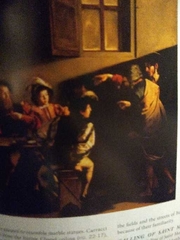
Tenebrism. |
Painting in a shadowy manner, using violent contrast of light and dark. Ex: Caravaggio. Calling of saint Matthew. Rome. Cardinal Del Monte. He threatened the whole classical tradition. |
|
|
|
Transubstantiation |
The transformation of the characteristic bread and wine into the body and blood of Christ. |
|
|
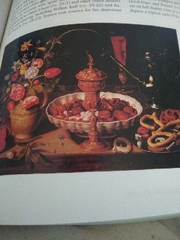
Breakfast piece |
A still life that includes bread and fruit. Clara Peeters. Still life with flowers, goblet, dried fruit and pretzels. Oil. Flanders. |
|
|

Camera obscura |
Latin for a lighted room. A device in which a small lens projects the image of an object downward onto a sheet of paper. Vermeer. Allegory of the art of painting. Oil. Dutch |
|
|
|
Fleur-de-lis |
Three petaled flower |
|
|
|
Memento mori |
Latin reminder for death. |
|
|
|
Still life. |
. |
|
|
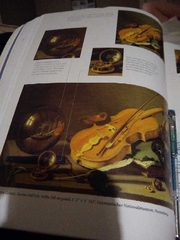
Vanitas |
Latin for vanity. A term describing paintings particularly 17th century Dutch still life that include reference to death. Pieter Claesz. Vanitas Still Life. Oil. Flanders. |
|
|
|
What impact did Protestant Reformation have on European art? How did the church's concerns shape the subjects in aesthetics counter Reformation art? this is a principal shift in the culture of this time And in these regions. |
the Catholic Church decided to sponsor more and more artists the beautifying agent for the Christian doctrine. Protestants, led by Martin Luther, wanted to ignore the idolatry of images and sculptures to focus on the Bible itself. Luther translated the Bible into German, the common tongue, and with the help of gutenberg's printing press has the Bible and its lessons spread throughout the lands. previously, the clergy and wealthy were the only ones who could read the Greek, Hebrew, or Latin text of the Bible. |
|
|
|
How is the Dutch baroque art different from Spanish baroque and Italian baroque? |
. |
|
|
|
how did the economic development impact the art of the Dutch republic? What groups commissioned art in the different territories in this unit? How did patreon change in the country is covered in this unit? Considering the Protestant affiliation and the Dutch republics, the visual flavor of the work has a far different quality than that of their Italian, Catholic counterparts. Look for every day seems to have a nod to religion, rather than shouting it from the rooftop. It will be a covert instead of overt. |
. |
|
|
|
what does baroque art work look like? Who are some of the leading Italian broke artists and architects? The drama either gets maxed out... Turn to 11, if you will. |
Caravaggio. Gentileschi. Pozzo. Bernini Boromi |
|
|
|
How did royalty in the wealthy get portrayed in their portraits? |
. Elaborate |
|
|
|
how did the rise of northern Europe's middle class spark new, different patronage in the Dutch and Flemish regions? Think of the genre scene idea again... Why were those so popular? |
now we're getting to the point where the average Joe and Jill or at least the more average Joe or Jill is capable of buying work. |
|
|
|
How do we see regional variations between Spain, France, Germany, the Netherlands, Italy, Flanders and the Dutch republic as we move through these chapters? Consider making a list of key aspects from each region. |
Netherlands were obsessed with proverbs and passion for detailed and clever imagery. |
|
|
|
Chateau |
"castle." Luxurious country residence . |
|
|
|
Gesso |
Plaster mixed with a binding material, used as the base coat for paintings on wood panels. |
|
|
|
Glaze |
codeine for pottery to seal and decorate the surface. Oil painting, Nathan transparent or semi-transparent are applied over a color to alter it slightly. |
|
|
|
Greek cross |
Across with four arms of equal length. |
|
|
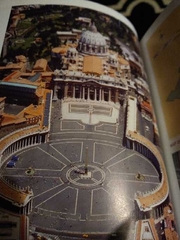
Piazza |
plaza. ex: Saint Peter's. Rome. Created by bernini and Michaelangelo. |
|
|
|
Proscenium |
The part of a theatrical stage in front of the curtain. |
|
|
|
what are the regional style difference between the regions be covered in this unit? France Germany Italy Spain and the Netherlands. What visual qualities do these regions share? Where do their visuals differ? |
. |
|
|

What is allegory? How was it used by artists at this time? |
an expressive style that uses fictional characters and events to describe some subject by suggestive resemblances. Ex: Gentileschi. Self portrait as the allegory of painting. Oil. London. |
|
|
|
What is still life painting? How did it use everyday objects in a meaningful way? |
A picture depicting an arrangement of inanimate objects. they were used in meaningful ways by being symbolic and representing something that the artist is trying to convey such as a skull representing death walnuts representing death making cheese representing death. |
|
|
|
Who was Caravaggio and why was he important question mark what aspects of his style were often imitated and emulated? |
He was considered the Antichrist of his time because he painted religious settings with ordinary people. His style was average looking people even for important people and very very dark shadows basically black AKA tenebrism. And he used Grim subjects for his paintings |
|
|
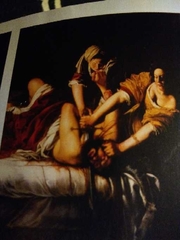
Who was gentileschi? What are the key aspects of her style? Who were the major female artists and patrons in this area? |
Gentileschi was a fierce woman painter who was inspired by Caravaggio. she integrated a lot of his styles that Caravaggio use such as ordinary people looking people and high contrast and even did her own depiction of the beheading of holofernes actually multiple. Because of her, it helped disseminate Caravaggio's style throughout the area. She loved doing narrative paintings of strong women. Ex: Judith slaying holofernes. Oil on canvas. Florence.
|
|
|

|
Bernini. Rome. Marble. Title is David. In the act of the kill. Patron is Cardinal Scipione Borghese. |
|
|
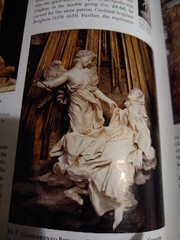
Proscenium |
the part of the stage in front of the curtain. Ex: Bernini. Marble. Rome. Ecstasy of Saint Teresa. |
|
|
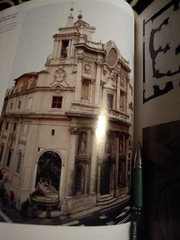
Greek cross. |
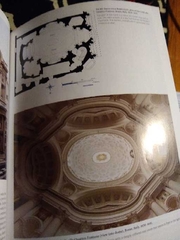
Cross with all four arms same size. Ex:Borromini. Facade of San Carlo all Quattro Fontane. Rome. Enhanced movement, with a dynamic counterpoint of concave. Deeply recessed niches. Two facades. |
|
|
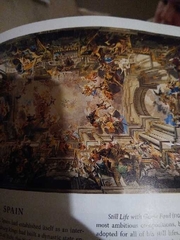
|
Fra Andrea Pozzo. Glorification of Saint Ignatius. Fresco. Nave of sant' ignazio. Rome |
|
|
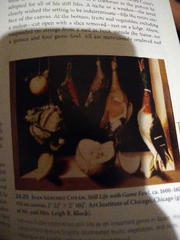
|
Juan Cotan. Still Life with game fowl. Oil. Spain. |
|
|
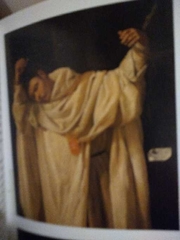
|
Francisco de Zurbaran. Saint Serapion. Oil. Spain. |
|
|
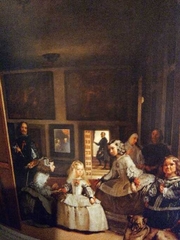
Super meta |
Diego Velazquez. Las maninas. Spain. Philip IV |
|
|
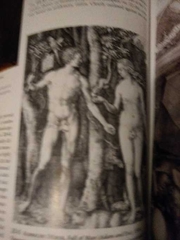
|
Albrecht Durer. Fall of Man. Engraving. Northern Eroupe. |
|
|
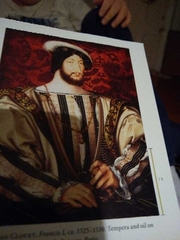
|
Jean clouet. Francis I. Paris. |
|
|

|
Pieter Aertsen. Butcher's stall. Oil. The Netherlands. |
|
|

|
Caterina van Hemessen. Self portrait. Oil. The Netherlands |
|
|
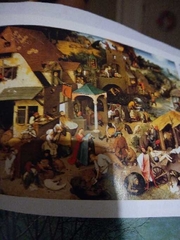
|
Pieter Bruegel the elder. Netherlandish proverbs. Oil on wood. Berlin.q |
|
|
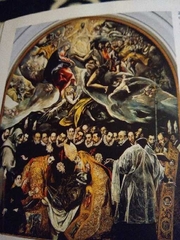
|
El Greco. Burial of Count Orgaz. Oil. Spain. |
|
|
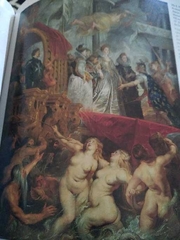
|
Peter Paul Rubens. Arrival of Marie de Medici at Marseilles. Oil. Flanders. Marie de Medici. |
|
|
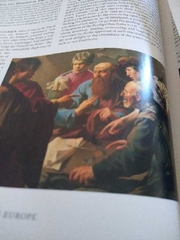
|
Brugghen, calling of Saint Matthew. Oil. Dutch republic. Softer tints and not as high contrast but still some use of tenebrism |
|
|

|
Judith leyster. Self portrait. Oil. Dutch. Her attire shows off her high status. |
|
|
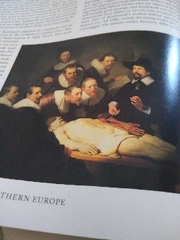
|
Rembrandt. Anatomy lesson of Dr. Tulp. Oil. Dutch. |
|
|
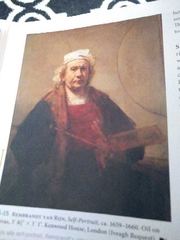
|
Rembrandt. Self-portrait. Oil. Dutch. Circles represent his virtuosity. |
|
|
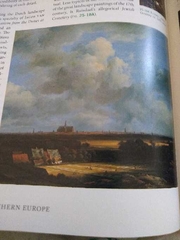
|
Jacob Ruisdael, Ciew of Haarlem from the Dunes at Overveen. Oil. Dutch |
|
|

|
Rachel Ruysch. Flower still life. Oil. Dutch. |
|
|
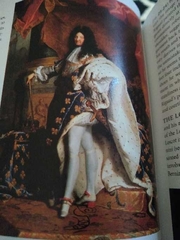
|
Rigaud. Louis the 14th. Oil. France. He was a dancer. Short so he created those specific heels. It was to make known his power. |
|
|
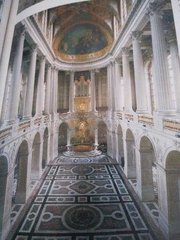
|

France. Versailles palace. Louis the 14th commissioned it. |

|
|
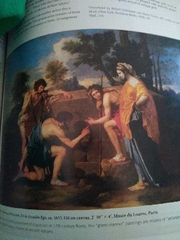
|
Nicolas Poussin. Et in Arcadia Ego. Oil. France |
|
|
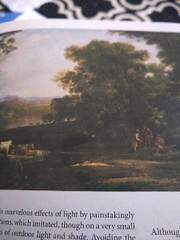
|
Claude Lorrain. Landscape with Cattle and Peasants. Oil. France. |
|
|
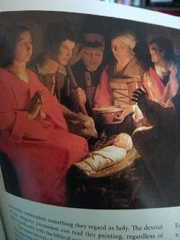
|
Momento mori (candle) Caravaggio's style. Georges De La Tour. Adoration of the Shephards. Oil. France |
|
|
|
Spain |
Period of some political decline following the 16th century when the country had established itself as an international power. Major player during the Thirty Year's War, but in spite of its efforts, the 17th century was marked by economic problems. Remains passionately Catholic under the Hapsbug family's control. Imports from Italy some similar techniques as used by Catholic artists there to create more emotionally moving paintings that would inspire greater devotion and piety in viewers. Uses similar effects of chiaroscuro, theatricality and immediacy as seen in the work of Caravaggio. Diego Velazquez is a dominant figure during this period. |
|
|
|
Flanders |
Since the 15th c is under the control of the Hapsburg family, the family that also controls Spain as well as parts of Italy and America. All territories under Hapsburg control are Catholic Art from Flanders (the Spanish-controlled area of the Netherlands) is closely connected to the Baroque art of Catholic Europe (Including Spain and parts of Italy) and shows similar concerns and idea |
|
|
|
Dutch |
Gains independence from Spain in the late 16th c and is officially recognized as the United Provinces of the Netherlands (Dutch Republic) in 1648 Economically prosperous area with highest income per capita in Europe. Political power is concentrated in the hands of an urban patrician class of merchants and manufacturers. Predominantly Protestant (and Calvinist) this equals inconoclasm in churches and few works of religious art made for other spaces. Home of the early Art Market due to this prosperity. See even greater production of genre scenes, land/seascapes, portraits |
|
|
|
French |
Louis XIV was the predominant figure in French political life during 1661-1715. The absolute ruler of France and his kingdom became the largest and powerful of the century. Religious conflict between catholics and protestants that lead to wars and the protestants were driven out. Lots of art was made for the state which was used for political purposes |
|
|
|
Italian |
Art of the Counter-Reformation- movement against Lutheranism. Tended to be religious; most art commissioned by the Church or the Pope. Use of dramatic/theatrical lighting to show MOST DRAMATIC MOMENT. Realistic figures, but not necessarily ideal. |
|
|
|
Differences between Dutch Baroque and Baroque in Catholic Regions (Italy, Spain, Flanders)
|
Dutch tended to be more genre scenes and normal, middle class figures, rather than religious depictions and highly decorated churches |
|

